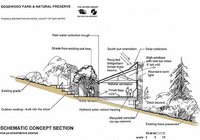
Kelly Hart of Green Home Building writes that "...As “consumers” we are frequently confronted with life style decisions that can impact our environment. There are a few choices in this life that can make a big difference in what the quality of life will be for those who follow us. Going with the flow of our culture is hard to avoid, and unfortunately the flow is not in the right direction for evolving a sustainable future.
uuOne of the most momentous choices that any of us will make is the kind of house we live in. I have come up with a list of thirteen principles of sustainable architecture that can guide you in your housing choices.
Small is beautiful. The trend lately has been toward huge mansion-style houses. While these might fit the egos of those who purchase them, they don't fit with a sustainable life style. Large houses generally use a tremendous amount of energy to heat and cool. This energy usually comes from the combustion of fossil fuels, depleting these resources and emitting greenhouse gases and pollutants into the air. Also, the larger the house, the more materials go into its construction; materials which may have their own environmental consequences. A home should be just the right size for its occupants and their activities. My wife and I (and our two dogs) have happily lived in a forty foot bus for the last four years. The key to this is efficient use of space, good organization, and keeping possessions to a manageable level. We do look forward to spreading out some in the passive solar, earthbag home we are building.
Heat with the sun. Nothing can be more comfortable for body and mind than living in a good solar-heated house. I say “good”, because proper design is crucial to the comfort of such a house. You may have gone into a solar house and felt stifled by the glaring heat, or perhaps you shivered from the lack of it. Good passive solar design will provide just enough sunlight into the rooms to be absorbed by the surrounding thermal mass (usually masonry materials), so that the heat will be given back into the room when the sun goes down. The thermal mass is a kind of “heat battery” that stores the warmth, absorbing it to keep the room from getting too hot during the day. Equally important to thermal mass is insulation (such as straw bales or crushed volcanic rock) that will keep that heat inside. Thermal mass materials need to be insulated from the outside, or else they will just bleed that warmth right back out. A rock house might have tons of mass, but be uncomfortably cold because of this energy bleed. So a good solar design will utilize materials of the right type in the right places, blending thermal dynamics with utilitarian design. There is much more to be said about solar design, and there are many good books on the topic.
Keep your cool. As I suggested above, a well designed solar house is both warm when you want it, and cool when you want it; that is to say, the temperature tends to stay fairly even. A good way to keep your cool is to dig into the earth. If you dig about six feet into the earth, you will find that the temperature there varies by only a few degrees year round. While this temperature (about 50-55 degrees F.) might be too cool for general living comfort, you can use the stability of the earth's temperature to moderate the thermal fluctuations of the house. If you dig into a south-facing hillside to build, or berm the north part of the house with soil, you can take advantage of this. The part of the house that is under ground needs to be well insulated, or the earth will continually suck warmth out of the house..."
Diagram courtesy of Recycle Works Organisation
No comments:
Post a Comment